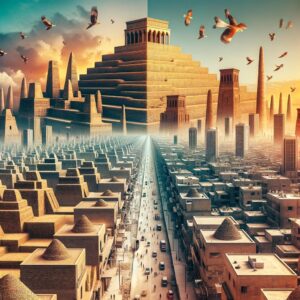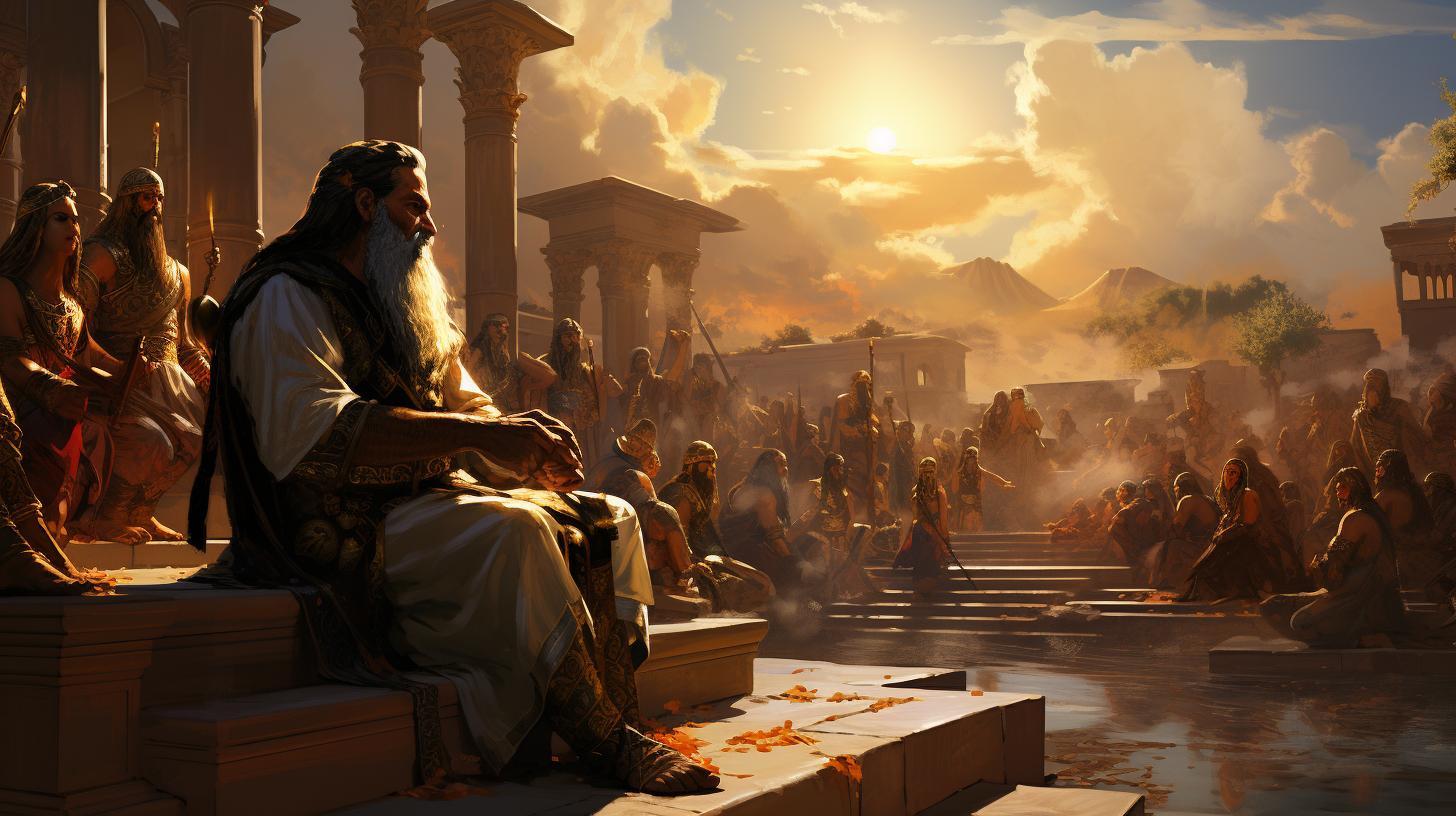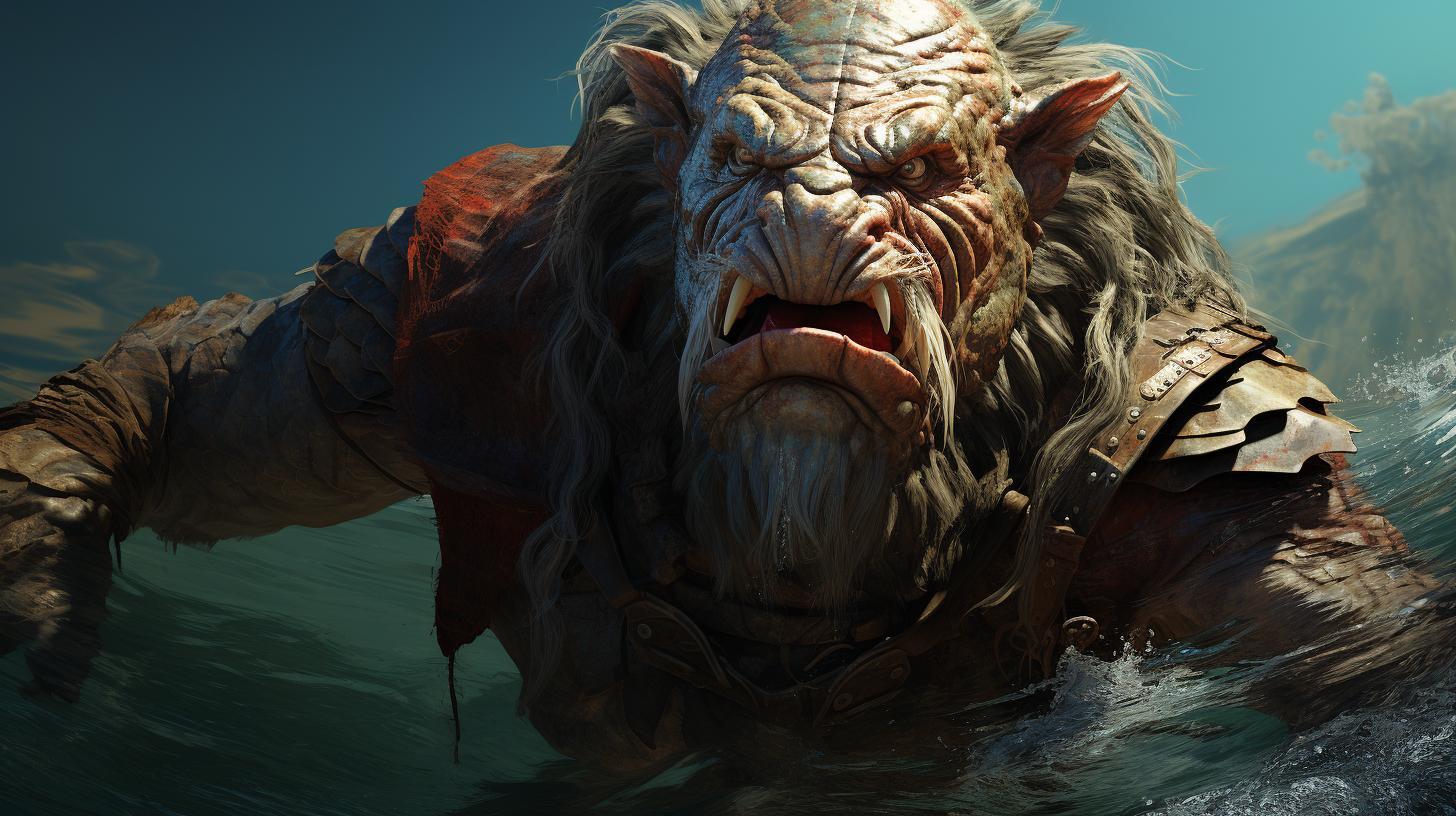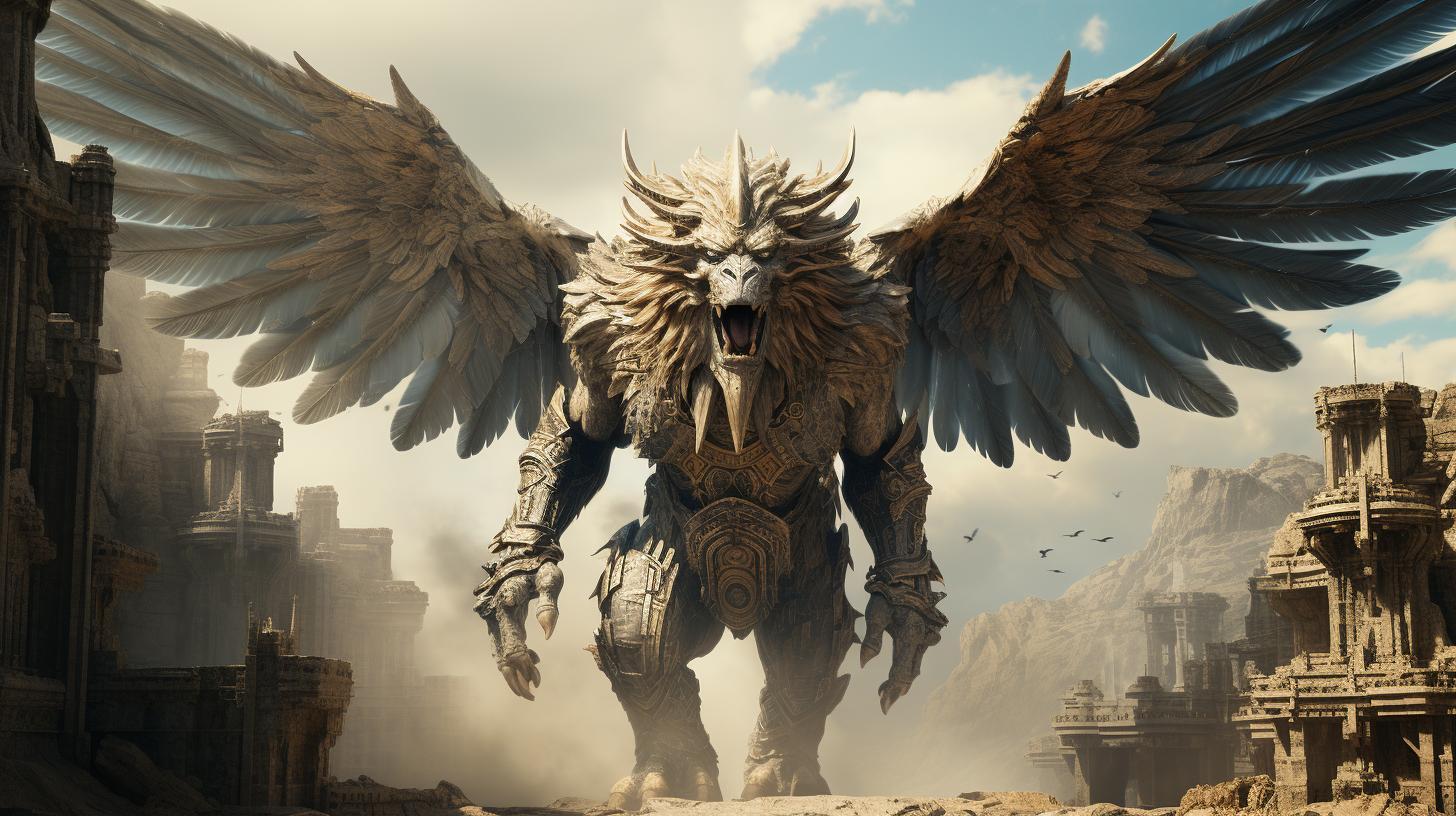Exploring Mesopotamian Mythology Gods and Goddesses: Unveiling Ancient Deities of Mesopotamia
Mesopotamian mythology is a rich tapestry of gods and goddesses that held great importance in the ancient civilizations of Sumer, Babylon, and Assyria. With roots in the cradle of civilization, these deities shaped the beliefs and practices of the Mesopotamian people.
From the moon god Nanna/Sin to the powerful rulers Enlil and Enki, each deity had a unique role and significance. Through ancient texts and rituals, we gain insight into their worship and the influence they had on the broader region.
Delve into the captivating world of Mesopotamian mythology as we explore its gods and goddesses.
List of the Mesopotamian Gods and Goddesses
Nanna/Sin: God of the Moon
In Mesopotamian mythology, Nanna, also known as Sin, was the prominent god associated with the moon. Considered one of the most important deities, Nanna/Sin held a significant place in religious beliefs and rituals of ancient Mesopotamia.
As the divine embodiment of the moon, Nanna/Sin was believed to possess immense power and influence over the natural world. Mesopotamians revered him for his role in governing the lunar cycles and believed he held sway over fertility, tides, and even human emotions.
Depicted as a wise and enigmatic figure, Nanna/Sin was often depicted donning a crescent moon on his head, symbolizing his connection to the celestial body. Ancient Mesopotamians offered prayers and performed rituals to seek favor and protection from this mighty lunar deity.
Nanna/Sin‘s worship extended across various Mesopotamian cultures, with dedicated temples, such as the famous Great Ziggurat of Ur, being built in his honor. These temples served as focal points for religious ceremonies and offerings made by priests and devotees to appease and communicate with Nanna/Sin.
In addition to his role as the moon god, Nanna/Sin was also associated with wisdom, divination, and dreams. It was believed that he had the ability to grant visions and impart wisdom to those who sought his guidance.
Moreover, he played a vital role in determining the fate of individuals through his influence on their dreams and interpretations by priests known as diviners.
The worship of Nanna/Sin had a lasting impact on the Mesopotamian civilization, shaping their religious practices, cultural beliefs, and even contributing to the development of astronomical studies. The moon’s cyclical nature and its connection to the changing seasons also influenced the Mesopotamians’ agricultural practices.
In conclusion, Nanna/Sin, the god of the moon, held immense significance in Mesopotamian mythology and religion. His association with the lunar cycles, fertility, and wisdom made him a revered and influential deity in the ancient Mesopotamian pantheon.
Mesopotamian Mythology: An Introduction
Mesopotamian mythology is a rich and ancient belief system that flourished in the historical region of Mesopotamia, which encompasses present-day Iraq, Kuwait, and parts of Syria and Turkey. It is a fascinating tapestry of myths, legends, and religious practices centered around a diverse pantheon of gods and goddesses.
The myths and deities of Mesopotamian mythology played a fundamental role in shaping the culture, society, and worldview of the ancient Mesopotamians. They provided explanations for the creation of the world, the origins of humanity, and the natural phenomena that surrounded them.
The ancient Mesopotamian pantheon consisted of various gods and goddesses, each with their own unique attributes, responsibilities, and spheres of influence. These deities were believed to possess both immense power and human-like characteristics, making them relatable figures for the people.
- Sumerian Gods and Goddesses: The Sumerians, the earliest known civilization in Mesopotamia, worshipped a vast array of deities. Some of the prominent Sumerian gods and goddesses include An, the sky god; Enki, the god of wisdom and water; and Nammu, the primordial goddess of the sea.
- Babylonian Deities: With the rise of Babylon as a major Mesopotamian power, the pantheon expanded to incorporate Babylonian gods and goddesses.Notable deities in Babylonian mythology include Marduk, the chief god and patron deity of the city of Babylon; Ishtar, the goddess of love, fertility, and war; and Nabu, the god of wisdom and writing.
Mesopotamian mythology reflects the complex interplay of various cultures and civilizations that thrived in the region over thousands of years.
It exudes a sense of awe, divine intervention, and the struggle between cosmic forces that shaped the lives of its followers.
In the following sections, we will delve deeper into the intriguing stories and characteristics of specific Mesopotamian deities, exploring their significance and the myths associated with them.
The Ancient Mesopotamian Pantheon
The Sumerians, one of the earliest civilizations in Mesopotamia, worshipped a diverse pantheon of gods and goddesses. Each deity represented different aspects of life, nature, and the cosmos. Among the prominent Sumerian deities were:
- Anu: The supreme god and ruler of the heavens.
- Enki: The god of wisdom, crafts, and freshwater.
- Inanna: The goddess of love, war, and fertility.
- Enlil: The god of wind, storms, and agriculture.
- Utu/Shamash: The sun god and divine judge.
These Sumerian gods and goddesses played crucial roles in the creation of the world and the establishment of society.
They were worshipped through grand temples and elaborate rituals that sought favor and protection.
Babylonian Deities
With the rise of Babylon as a dominant power in Mesopotamia, the pantheon of gods and goddesses underwent some changes. The Babylonians incorporated deities from earlier civilizations, adapting them into their own beliefs and religious practices.
Some of the key Babylonian deities included:
- Marduk: The supreme god of Babylon, associated with creation and the protection of the city.
- Ishtar: The goddess of love, beauty, and war.
- Nabu: The god of writing, wisdom, and scribes.
- Bel: The god of storms, weather, and fertility.
- Tiamat: The primordial goddess of chaos and the sea.
The Babylonians developed a complex mythology surrounding these deities, with epic tales and religious texts providing insights into their roles and interactions.
Worship of these Babylonian gods and goddesses involved sacred rituals, sacrifices, and the construction of massive temples.
Nanna/Sin: The Lunar Deity
In the enchanting realm of Mesopotamian mythology, Nanna, also known as Sin, stood as the prominent god of the moon. As the divine embodiment of the lunar cycle, Nanna commanded immense reverence among the ancient Mesopotamians.
His sphere of influence extended beyond the nocturnal sky, permeating the realms of fertility, wisdom, and divine protection.
Nanna/Sin was regarded as the fatherly figure of the gods, overseeing the well-being of humanity and acting as a guiding light during challenging times. Worshipers believed that his radiant presence illuminated the night, offering solace and reminding mortals of the cyclical nature of life.
The moon, for its part, symbolized the passage of time, marking the seasons, and dictating the tides.
Accompanied by his celestial entourage, Nanna/Sin traversed the heavens in a majestic celestial barque, casting his benevolent gaze upon Earth. His nocturnal journeys were celebrated in rituals and festivals, where people offered prayers and sacrifices to honor his divine presence.
The Mesopotamians deeply believed that by honoring Nanna/Sin, they could receive blessings of fertility, protection, and divine guidance in their daily lives.
- Nanna/Sin was often depicted as a wise and caring god, adorned with a crescent moon headdress, symbolizing his lunar domain. The statuettes and reliefs portraying him showcased his comforting and nurturing nature, captivating the hearts of his followers.
- His prominent role in the Mesopotamian pantheon emphasized the deep connection between the celestial bodies and the mortal sphere.The phases of the moon were interpreted as signs and omens, guiding the decisions of rulers, predicting bountiful harvests, and even foretelling the fate of individuals.
- The sacred city of Ur was the primary center of Nanna/Sin worship, housing the grandiose ziggurat E-anna as the focal point of his reverence.Pilgrims from far and wide embarked on spiritual journeys to seek the favor of Nanna/Sin and engage in rituals that strengthened their bond with the celestial deity.
The enduring legacy of Nanna/Sin in Mesopotamian mythology is a testament to the profound influence of lunar symbolism and the significance of celestial bodies in ancient cultures.
Delving deeper into the captivating realm of Mesopotamian gods and goddesses, we unravel layers of wisdom, unraveling the tapestry of beliefs that shaped the lives of the ancient Mesopotamians.
Enlil and Enki: The Divine Rulers
In Mesopotamian mythology, Enlil and Enki hold prominent positions as divine rulers and figures of immense power. Each deity governs over distinct domains and plays a crucial role in shaping the world and its inhabitants.
Enlil, also known as Ellil, is the chief god of the ancient Mesopotamian pantheon. He presides over the forces of nature, particularly wind, storms, and agriculture. As the god of the air, Enlil possesses great authority and is often depicted as a bearded figure holding a mace or thunderbolt.
On the other hand, Enki, also called Ea, is the god of freshwater, wisdom, and magic. He is associated with the cosmic ocean and controls the subterranean waters believed to be the sources of life and fertility.
Enki is often portrayed as a bearded deity wearing a horned cap and carrying a scepter or a bucket.
Enlil and Enki have a complex relationship in Mesopotamian mythology—their dynamic often reflects a balance between order and chaos, creation and destruction. Enlil represents the authoritative and sometimes stern aspect of divinity, while Enki embraces wisdom, creativity, and benevolence.
These divine rulers feature prominently in ancient myths and epics, where their actions and decisions shape the destinies of gods and humans alike. Enlil‘s role in the Great Flood narrative, for instance, highlights his power and the consequences of his decisions on humanity.
Enki, on the other hand, is credited with many acts of beneficence towards humans. He gifts them with knowledge, crafts, and often serves as their advocate. Enki‘s role in creating humans in certain narratives demonstrates his benevolent nature and connection with the mortal realm.
The stories and legends surrounding Enlil and Enki offer a glimpse into the complex belief systems and the interplay between gods and humans in ancient Mesopotamia. Their influence can be seen not only in religious practices but also in societal structures and cultural traditions that endured for thousands of years.
Inanna: The Mesopotamian Goddess of Love and War
Inanna, also known as Ishtar, was a prominent goddess in Mesopotamian mythology. She held dominion over various aspects of life, including love, beauty, fertility, and war. As the goddess of love and war, Inanna embodied both nurturing and destructive qualities, reflecting the dual nature of human existence.
According to ancient texts, Inanna was the daughter of Nanna/Sin, the moon god, and served as the Queen of Heaven. She was depicted as a powerful deity, adorned with royal symbols and often accompanied by lions, which represented her regal authority.
Inanna’s role as the goddess of love was associated with passion, desire, and fertility. She was believed to bestow blessings upon couples, ensuring the success of their relationships and the growth of their families.
Temples dedicated to Inanna served as sacred spaces for rituals centered around love, marriage, and procreation.
However, Inanna’s dominion over warfare should not be overlooked. As the goddess of war, she was invoked by kings and warriors seeking victory in battle. Inanna’s presence on the battlefield was believed to inspire bravery and grant divine protection to her followers.
One of the most notable tales involving Inanna is the ‘Descent of Inanna,’ where she journeys to the underworld to confront her sister, Ereshkigal. This myth highlights Inanna’s ability to navigate and transcend different realms, emphasizing her role as a mediator between gods and humans.
Inanna’s influence extended beyond Mesopotamia, as she was venerated in other ancient civilizations, such as the Akkadians and Babylonians. Her worship was often associated with grand festivities and lavish rituals, demonstrating the profound impact she had on the religious and cultural practices of the region.
Today, the legacy of Inanna continues to inspire artists, scholars, and those interested in the rich tapestry of Mesopotamian mythology. Her portrayal as a complex deity embodies the intricacies of human existence and serves as a reminder of the diverse aspects of life that humanity has sought to understand and honor throughout history.
Associated Deities in Mesopotamian Mythology
In addition to the prominent gods and goddesses we have already explored, the rich tapestry of Mesopotamian mythology features numerous associated deities who played significant roles in the ancient pantheon. These lesser-known divinities contribute to the intricate web of interconnectedness within the mythological framework of Mesopotamia.
Some of these associated deities include:
- Anu: The sky god and the highest deity in the Mesopotamian pantheon.
- Ereshkigal: The goddess of the underworld, ruling over the realm of the dead.
- Ishtar: A powerful goddess of love, beauty, war, and fertility.
- Nergal: The god of war and plague, associated with the underworld.
- Ninurta: The god of agriculture, hunting, and war, often depicted as a heroic warrior.
- Ningal: The consort of Nanna/Sin, she is the goddess of reeds and the mother of Inanna.
- Ninhursag: The mother goddess, associated with fertility, birth, and the earth.
These associated deities bring additional depth and complexity to the Mesopotamian belief system, representing various aspects of life, nature, and the cosmos.
Each one has distinct attributes, roles, and narratives that contribute to the overall tapestry of Mesopotamian mythology.
Mesopotamian Gods in Ancient Texts
Mesopotamian mythology encompasses a rich collection of ancient texts that provide valuable insight into the gods and goddesses of the region. These texts, written in various languages such as Akkadian, Sumerian, and Old Babylonian, offer glimpses into the beliefs and stories surrounding these deities.
Let’s explore two significant categories of ancient texts that shed light on Mesopotamian mythology: Akkadian and Sumerian Texts, and Old Babylonian Literature.
Akkadian and Sumerian Texts
In the realm of Mesopotamian mythology, Akkadian and Sumerian texts hold immense importance. They serve as vital sources for understanding the pantheon of gods and goddesses worshipped by the ancient Mesopotamians.
These texts include mythological narratives, hymns, and rituals that portray the characteristics, attributes, and relationships of deities such as Enlil, Enki, and Inanna. They provide valuable insights into the roles and influences of these divine beings in the lives of the Mesopotamian people.
Old Babylonian Literature
Old Babylonian literature, another crucial category of ancient texts, contributes significantly to our understanding of Mesopotamian gods and goddesses. These texts include epic poems like the ‘Epic of Gilgamesh,’ which prominently features divine figures and their interactions with humans.
They provide captivating accounts of deities like Ishtar, Ea, and Marduk, highlighting their powers and their involvement in shaping the world and human destiny. By studying these texts, we delve deep into the belief systems and cultural significance of Mesopotamian deities.
Worship and Rituals of Mesopotamian Deities
Mesopotamian gods and goddesses held significant importance in the lives of the ancient people, who deeply revered and worshipped them. Rituals and ceremonies played a crucial role in connecting with these divine entities, seeking their favor, and ensuring the well-being of the community.
Worship in Mesopotamian mythology was highly structured and involved various rites and offerings. Temples were the main centers of religious activities, serving as sacred spaces where the deities resided. These temples had dedicated priests and priestesses who performed elaborate rituals on behalf of the people.
One common form of worship was through sacrifices, where animals or food items were offered to the gods and goddesses. These offerings were seen as acts of devotion and gratitude, aimed at gaining their blessings and protection.
The choice of sacrificial animals and the specific rituals performed varied depending on the deity being worshipped.
Another integral part of Mesopotamian religious practices was divination, a method of seeking guidance or interpreting the will of the gods. Diviners, known as baru or bārû, would use various techniques such as examining the liver of a sacrificial animal or interpreting dreams and omens to provide insights into the future.
Feasts and festivals were also crucial in honoring the Mesopotamian deities. These gatherings, often held in the temples, involved communal celebrations, music, dances, and processions. They served as occasions for individuals to come together, express their devotion, and renew their connection with the divine.
- Offerings and sacrifices
- Divination and seeking guidance
- Feasts and festivals
The religious practices and rituals surrounding Mesopotamian gods and goddesses were deeply ingrained in the society, shaping the daily lives and belief systems of the ancient people.
Through these worship and rituals, the Mesopotamians sought to maintain harmony with the divine realm, seeking protection, prosperity, and divine intervention in their lives.
Influence of Mesopotamian Gods and Goddesses on Ancient Near East
The influence of Mesopotamian gods and goddesses extended far beyond the boundaries of Mesopotamia itself, reaching and leaving a profound impact on the neighboring regions of the Ancient Near East. These powerful deities held positions of high significance in the religious and cultural practices of various civilizations that were exposed to Mesopotamian mythology.
1. Sumerian Gods and Goddesses: The deities worshipped in Sumer, the earliest known civilization in Mesopotamia, greatly influenced the religious beliefs and practices of subsequent cultures. Many Sumerian gods and goddesses were adopted and adapted by other civilizations in the region, such as the Babylonians and Assyrians.
2. Babylonian Deities: The Babylonians, who succeeded the Sumerians, incorporated numerous Mesopotamian gods and goddesses into their pantheon. Deities like Marduk, the patron god of Babylon, attained prominence and became central figures in the religious and political life of Babylonian society.
These Mesopotamian deities served as a source of inspiration for neighboring cultures, influencing their own divine hierarchies, religious rituals, and mythological narratives. The impact of these gods and goddesses was particularly evident in regions such as Canaan, Anatolia, and the Levant.
3. Art and Iconography: The influence of Mesopotamian gods and goddesses can also be observed in the art and iconography of the Ancient Near East. The artistic representations of Mesopotamian deities, their symbols, and mythical scenes were adopted and adapted by neighboring civilizations, reflecting the cultural exchange and veneration of these powerful entities.
4. Trade and Cultural Exchange: Mesopotamia served as a major center for trade and cultural exchange in the Ancient Near East. As a result, the beliefs and practices associated with Mesopotamian gods and goddesses spread throughout the region, shaping the religious landscapes and influencing the spiritual ideologies of diverse civilizations.
The influence of Mesopotamian mythology on the Ancient Near East cannot be overstated. The gods and goddesses of this ancient pantheon held sway over the hearts and minds of countless people, leaving an indelible mark on the religious and cultural tapestry of the region.
Modern Interpretations and Impact
Throughout history, Mesopotamian mythology has continued to captivate and inspire individuals across different fields, leaving a lasting impact on various aspects of modern society.
- Literature and Arts: Mesopotamian myths and deities have served as a rich source of inspiration for countless works of literature, poetry, and art. Writers and artists have drawn upon the tales of ancient gods and goddesses to create compelling narratives and vibrant visual representations.
- Pop Culture: Mesopotamian mythology has found its place in popular culture, with references to the gods and goddesses appearing in movies, television shows, and video games.These portrayals not only entertain audiences but also contribute to the preservation and dissemination of ancient beliefs.
- Spiritual and Religious Practices: In some modern spiritual and religious movements, individuals have incorporated elements of Mesopotamian mythology into their practices, seeking a connection to the ancient deities and their wisdom.This syncretism showcases the enduring fascination with this ancient pantheon.
- Historical and Archaeological Research: Continued exploration and excavation of ancient Mesopotamian sites provide valuable insights into the mythology, religious practices, and societal beliefs of the past.Scholars and researchers uncover new discoveries that shed light on the significance of Mesopotamian gods and goddesses.
The impact of Mesopotamian mythology on modern society goes beyond entertainment and scholarly pursuits.
It serves as a reminder of our collective human history, the diversity of belief systems, and the power of ancient narratives to shape our present cultural landscape.
Further Reading and Resources
If you want to delve deeper into the enchanting world of Mesopotamian mythology gods and goddesses, the following resources and readings will provide you with valuable insights and expand your knowledge:
- ‘Mesopotamian Mythology: A Captivating Guide to Ancient Near Eastern Myths’ by Matt Clayton: This comprehensive book offers a captivating exploration of the ancient myths and deities of Mesopotamia, providing a rich understanding of their roles and significance.
- ‘The Treasures of Darkness: A History of Mesopotamian Religion’ by Thorkild Jacobsen: Focusing on the religious practices and beliefs of Mesopotamia, this scholarly work delves into the rituals, cults, and divine figures that shaped the civilization’s spirituality.
- ‘Gods, Demons and Symbols of Ancient Mesopotamia: An Illustrated Dictionary’ by Jeremy Black and Anthony Green: An indispensable reference guide, this book offers detailed descriptions and illustrations of various Mesopotamian gods, goddesses, demons, and symbols, providing a visual exploration of the pantheon.
- ‘Myths from Mesopotamia: Creation, The Flood, Gilgamesh, and Others’ edited by Stephanie Dalley: This collection of translated texts provides a captivating glimpse into Mesopotamian mythology, featuring important narratives such as the Epic of Gilgamesh and the Enuma Elish.
- ‘The Ancient Mesopotamian City’ by Marc Van De Mieroop: To gain a deeper understanding of the context in which Mesopotamian mythology developed, this book explores the cities and societies of ancient Mesopotamia, shedding light on the religious and cultural backdrop.
By consulting these resources, you’ll embark on an enlightening journey through the depths of Mesopotamian mythology, uncovering the secrets of gods and goddesses that shaped an ancient civilization.





